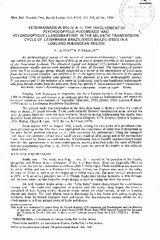Mostrar el registro sencillo del ítem
Leishmaniasis in Bolivia. II. The involvement of Psychodopygus Yucumensis and Psychodopygus LLanosMartinsi in the selvatic transmission lowland subandean region
| dc.contributor.author | Le Pont, F | |
| dc.contributor.author | Desjeux, P | |
| dc.date.accessioned | 2017-05-18T14:59:32Z | |
| dc.date.available | 2017-05-18T14:59:32Z | |
| dc.date.issued | 1986 | |
| dc.identifier.uri | http://repositorio.umsa.bo/xmlui/handle/123456789/10518 | |
| dc.description.abstract | An epidemiological survey of the vectors of cutaneous leishmaniasis ("espúndia" type) was carried out in the Alto Beni region of Bolivia, an area of Andean foothills at the Eastern limit of the Amazonian lowlands. The climate is typical wet tropical (15°S latitude). Anthropophilic phlebotomine sandfly species were sampled at 20 sites, all forested. The importance of species from the Psychodopygus group, already suspected as a vector in the transmission of Leishmania from the braziliensis complex, was confirmed by: 1) the aggressiveness and diversity of the species encountered (83% of catches, nine species), 2) the discovery of o new anthropophilic species, P. yucumensis and 3) the isolation of a strain of Leishmania braziliensis braziliensis indistinguisha- ble from human strains from the same area, from two species, P. llanosmartinsi and P. yucumensis. | es_ES |
| dc.language.iso | en | es_ES |
| dc.publisher | Mem. Inst. Oswaldo Cruz | es_ES |
| dc.subject | LEISHMANIASIS EN BOLIVIA | es_ES |
| dc.subject | PSYCHODOPYGUS | es_ES |
| dc.subject | LEISHMANIASIS CUTÁNEA | es_ES |
| dc.subject | REGIÓN SUBANDINA | es_ES |
| dc.title | Leishmaniasis in Bolivia. II. The involvement of Psychodopygus Yucumensis and Psychodopygus LLanosMartinsi in the selvatic transmission lowland subandean region | es_ES |
| dc.type | Article | es_ES |

